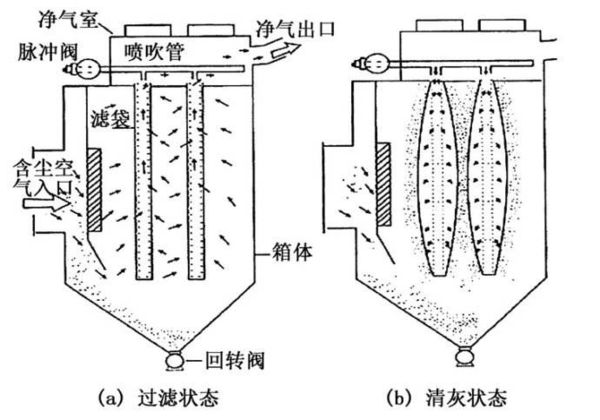


Understanding Pulse Bag Dust Collectors; Before understanding the working principle, we first know that the pulse bag filter consists of five parts: a cover plate, a fan, and an exhaust port; Lower box: including porous plate, skeleton, filter bag, air inlet, and maintenance door; Dust cleaning system: including controller, electromagnetic pulse valve, air bag, and spray pipe. The pulse bag filter body is divided into several box areas, with 32, 64, and 96 dust removal bags in each box, and there is a lift valve driven by a cylinder on the outlet pipe on the side of each box. When the pulse bag filter filters the dusty gas for a certain period of time (or when the resistance reaches the preset value), the dust cleaning controller sends a signal, and the lift valve of each chamber begins to close, cutting off the filtered airflow. Then, the pulse valve of the chamber opens, and compressed air greater than 0.4 MPa is injected into the clean air chamber to remove the dust on the dust bag. When this action is completed, the lift valve will reopen, allowing the chamber to resume filtering work, and complete all dust cleaning actions one by one according to the above procedure.
The working principle is that when the pulse bag filter equipment is working normally, the dusty gas enters the ash hopper through the air inlet. Due to the expansion of the gas volume, some of the coarser dust particles fall into the ash hopper due to inertia or natural settling, while the rest of the dust particles rise into the bag chamber with the airflow. After being filtered by the filter bag, the dust particles are trapped on the outside of the filter bag. The purified gas enters the upper box from the inside of the filter bag and is then discharged into the atmosphere through the valve plate hole and exhaust outlet, thus achieving the purpose of dust removal. As the filtration continues, the resistance of the dust collector also increases. When the resistance reaches a value, the dust cleaning controller issues a dust cleaning command, first closing the lifting valve plate and cutting off the filtered airflow; Then, the dust cleaning controller sends a signal to the pulse solenoid valve, and as the pulse valve sends high-pressure reverse airflow used for dust cleaning into the bag, the filter bag swells and produces strong shaking, causing the dust on the outside of the filter bag to shake off, achieving the purpose of dust cleaning. Due to the fact that the equipment is divided into several box areas, the above process is carried out box by box. While one box area is cleaning, the remaining box areas are still working normally, ensuring the continuous and normal operation of the equipment. The key to being able to handle dust is the cleaning time required for this strong cleaning.
http://www.hbfxhb.com
